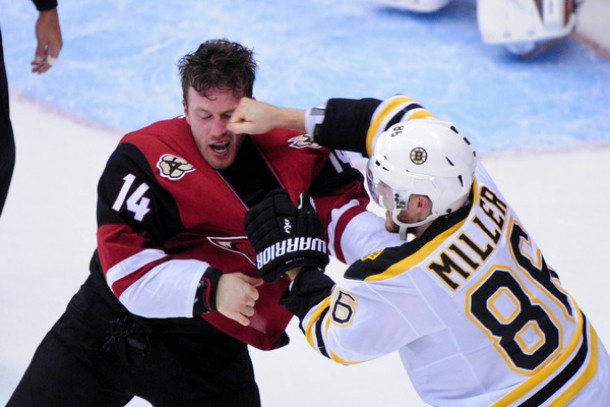"Anybody who says they don't like fighting in the NHL have to be out of their minds." - Don Cherry
That is a quote by one of the most powerful and iconic men in hockey, former coach of the rough and tough Boston Bruins when they were transitioning from superstars, to lunch box hockey players. It's known around the hockey universe that Don Cherry is an activist for fighting into the NHL, but there are many more opinions out there.
Steve Yzerman, Hall of Famer and former NHL superstar with the Detroit Red Wings, spoke out after an ugly incident between Colton Orr of the Toronto Maple Leafs and George Parros of the Montreal Canadiens.
Yzerman said, "We’re stuck in the middle and need to decide what kind of sport do we want to be. Either anything goes and we accept the consequences or take the next step and eliminate fighting."
From 2001-02 until the 2014-15 season, the amount of fights per game have reduced by almost half from 0.65 fights per game to a 0.32 fights a game. With the current rate in the 2015-16 season, that number has dropped again to a mere 0.27 fights per game. The number of multi-fight games between the same period dropped from 172 games in 2001-02 down to 45 in 2014-15.
All of those statistics can be attributed to the loss of enforcers. The NHL has become so fast that enforcers, the strictly tough guys, have dropped. You need to be able to skate and skate hard to play in the NHL. The teams have become better, deeper overall hockey clubs. The mindset of coaches on slowing down star players has gone and a counter with four lines that can play good, hard hockey has taken over.
Take a look at the Chicago Blackhawks, a modern day dynasty, with three Stanley Cups in the past six years and still a strong team even with the salary cap. They have four offensive lines and three lines of defenseman that can play good, all-around hockey. That's the way the league has gone, and this has pushed guys like George Parros and Colton Orr out of the league and replaced with guys who can play the game effectively at both ends of the ice.
While skill has taken over, fighting is still a tool used to change momentum, keep players honest and allow the players to self-police each other. You are a lot more cautious and aware of your behavior when you have someone to answer to on the other team. It's been well documented that the fighters on each team are some of the most beloved players in the dressing room, by the fans and in the community.
Some disagree with the way fighting is utilized in the sport and held to such praise. Parents worry about their kids looking up to and idolizing such acts and players especially when their kids are playing minor hockey. There has been a lot of discussion within the league about abolishing the rough and tumble but the players and certain management personnel are against removing it from the game.
Talking to some hockey fans who also play the game brought forth some notable quotes. Chris Armstrong from South Western Ontario is for fighting in the league. When asked what the purpose of fighting is, he responded, "The lack of respect between players stems from the fact that players are not held accountable for their actions by other players, self-policing if you will."
When James Desjardine, also from South Western Ontario was asked the same question, he said, "I feel fighting needs to be apart of hockey. The skilled players and goalies need to feel safe when playing. Wayne Gretzky wouldn't have amassed all of those records if it wasn't for players like Dave Semenko." Mr. Desjardine then added, "Hockey is a team sport, and all skill sets are apart of that team. From penalty killing to power play, they all serve a purpose."
All players are just cogs in the big hockey machine we all tune into throughout the season. Asking the same people what they think of the introduction of the instigator rule, a rule that tacks on a two minute minor to the already five minute major, to deter people from fighting. Mr. Armstrong isn't a fan. "My opinion is that the players have become a lot braver since the rule was brought in. You don't have to worry as much about dealing with a guy that can throw down if you cheap shot someone."
A good example of this is watching Sidney Crosby. He gets knocked around constantly, up and down the ice, night in and night out. When Gretzky was playing he had a player you had to answer to, you didn't get away with things like that. Asking Mr. Desjardine about if the instigator rule he had the same opinion. "It definitely hurt fighting. When another player deliberately attempts to hurt an opposing player, the normal reaction is to jump in and defend your teammate. So for sticking up for a teammate, you are punished? That's why the pests of the game get away with things and are so effective at what they do. They can do these things without having to fight or pay the price for their actions every time they pull these stunts."
When asked if these two men thought that fighting would be taken out of the game and what would happen if it did, they had some passionate responses. From Chris he felt it would be a detriment to the game. "There is no question that fighting will be taken out. They are slowly removing the physicality of the game. The result is a much less interesting and entertaining game. Guys will continue to get hurt. Missing a handful of games isn't the same as answering to a Todd Bertuzzi or a Cam Neely."
His example was the Todd Bertuzzi/Steve Moore incident. This event was one of the more dark parts of the NHL. Steve played for the Colorado Avalanche and was trying to solidify a job in the NHL. Playing against Todd Bertuzzi and the Vancouver Canucks. Moore took a cheap shot at the Canucks star player Marcus Naslund leaving him concussed. Moore wouldn't fight and stick up for his action. That would have been the end of it. So the next game they had a confrontation and Bertuzzi punched him from behind, ending Moore's hockey career.
James is scared that fighting leaving the game would leave star players vulnerable. "I'm afraid that if fighting was banned, a lot of liberties would be taken on the smaller, less aggressive players. Fighting, in hockey, keeps everyone honest."
Parker White, a fellow VAVEL contributor, was also asked some questions. He never played hockey growing up, wasn't raised in hockey-crazed Canada and is relatively new to the sport. When asked what drew him to the sport in the first place. He said it was the physicality and athleticism of the sport that made it entertaining to him. If fighting was important to his viewership he was neutral. "I'm in the middle. As a fan, it's entertaining. But I really don't understand the point. Guys get hit and knocked around in football and basketball and you can't have a brawl. But I'm not outraged about it. I've always known it to be part of the game."
Whether you're for or against fighting in the game, it is entertaining and its purpose changes from when you do and don't play the game. It's an extremely fast, physical and highly competitive sport. Every player is looking to make an impact in any way they possibly can, whether it's a big hit, setting up a play, or blocking shots. The fines, suspensions and amount of acceptable hits have changed and made it harder to make a physical impact on a game.
The lawsuits on the league from former players for concussion problems has a toll on the opinion of those in power and certainly has weight with every player currently playing, but many players want it in the game and agree it has a place. The mental health relations are there and something nobody wants, but it's a hard debate to take part in. These players know their roles, know the rules, and know the sport. It is a contact sport and fighting comes with the territory.
There have been many iconic rough and tumble teams, from The Broad Street Bullies in Philadelphia, to The Big Bad Bruins in Boston. The league and Gary Bettman are inching closer to pushing it out of the sport. Is it what's best for the sport? Who is to say what is right and wrong for the sport. All we can do is wait and see how it all unfolds in the years to come.









































